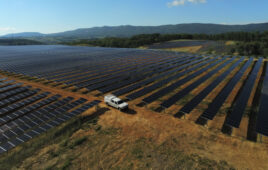The small village of La Farge, Wisconsin, was under water in 2018 after its worst flood ever.
The flooded Kickapoo River damaged the local electric co-op’s generator and substation and left the city without power for several days. The town’s only gas station was also flooded, so residents who didn’t have power had to drive 20 to 30 miles to get gas to power their diesel generators, said Samantha Laskowski, innkeeper at La Farge’s Green Apple Inn Bed and Breakfast.
“We were lucky we didn’t lose power, but the power line that comes into our neighborhood is right there, right along the river,” Laskowski said. “Some big log could have come and knocked it down and then we would have all been out of power. So that really made the need to have some sort of storage backup really important at that point.”
A group of forward-thinking residents led by Laskowski decided it was time to procure some energy resiliency for the community.
They contacted Current Electric (No. 172 on the 2020 Top Solar Contractors list), based over 160 miles away in Wauwatosa, and asked about their options.
Laskowski said she and her group did most of the research for the installations ahead of time and presented them to the La Farge Village Hall members, who were grateful for the solutions to their energy pains.
“I got the feeling that this town had a very pro-solar group, which kind of aligns itself with getting people to be pro-solar at a town level and a community level,” said Current Electric president and owner Chuck Smith. “They found out that Tesla had their Powerwalls, they contacted us and said, ‘How can we make this happen?'”
A few buildings in the village already had rooftop solar installations, so Current Electric got to work making public and private partnerships to add storage to them and allow the buildings to go off-grid if necessary. The installer individually contracted with the Green Apple Inn Bed and Breakfast, the Lawton Memorial Library and a residential property.
Laskowski said the library solar + storage installation was important so the location can serve as a community gathering place in case of future outages. Residents could go there to make plans and use the internet if they didn’t have power at home.
“They wanted something for emergency services and the community to have someplace to go in case of a power outage or another flood,” said Ray Hoffman, sales and marketing manager at Current Electric. “Those three spots are pretty high up, so there’s not as many issues there. And it provides that emergency location.”
Current Electric is a certified Tesla installer with experience installing solar + storage systems. In November 2019, the crew installed seven grid-tied Powerwalls set up for self-consumption at the three locations. The batteries integrated easily into the existing systems, even one with a 10-year-old inverter.
“There were some concerns whether the Tesla Powerwall would integrate well with that inverter, and it turns out it did integrate very well with an inverter that’s been running for over a decade,” said Brad Koepke, solar manager at Current Electric. “Obviously, Tesla Powerwall technology is much newer technology, so it’s really a great product for anybody who needs it, especially in a retrofit of an existing solar system.”
The biggest challenge for this and any solar + storage system, Smith said, is calculating the load size and “predicting the unpredictable” as to how long a customer might be without power.
“That said, though, the Powerwall provides you time,” Smith said. “If they know their utility isn’t going to be able to get [the grid] back up and running, they have time to make other means now if they absolutely need to.”
For a disaster as catastrophic as the 2018 floods, that would have meant extra time for the American Red Cross or other emergency relief services to mobilize to help the community.
“Unfortunately, that’s not what happened in the case of La Farge, and they felt very abandoned by their utility company, which is why they’re switching to self-reliance on their power,” Koepke said.
 The utility’s generator and substation still haven’t been moved to a safer, higher area out of the potential flood zone due to funding issues, Laskowski said. Now, the town at least has a few reliable energy-independent locations in case another disaster strikes. Laskowski is working to bring even more solar + storage resiliency to the town in the future.
The utility’s generator and substation still haven’t been moved to a safer, higher area out of the potential flood zone due to funding issues, Laskowski said. Now, the town at least has a few reliable energy-independent locations in case another disaster strikes. Laskowski is working to bring even more solar + storage resiliency to the town in the future.
Smith said energy self-reliance seems even more important now as the world deals with the COVID-19 pandemic. Keeping power on for the most important loads, like hospitals and other emergency services, is a life or death matter.
“I mean, we went through not having masks and toilet paper and everything else, but probably more critical would’ve been if we didn’t have power,” Smith said.
This story was featured exclusively in our 2020 Top Solar Contractors issue. See the issue and full list of top U.S. solar installers here.








Tell Us What You Think!